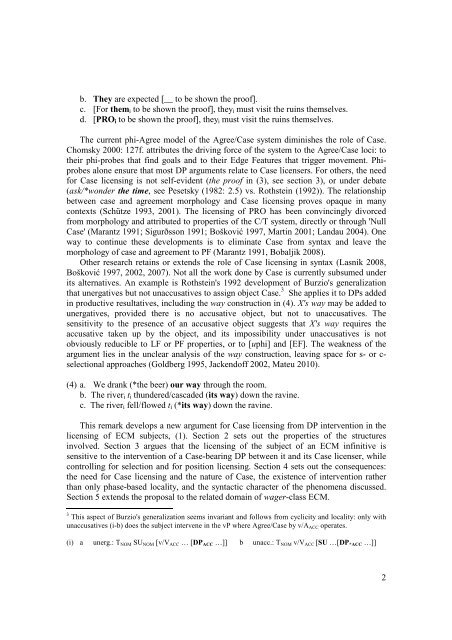Case Filter - UMR 7023 - CNRS
Case Filter - UMR 7023 - CNRS
Case Filter - UMR 7023 - CNRS
You also want an ePaper? Increase the reach of your titles
YUMPU automatically turns print PDFs into web optimized ePapers that Google loves.
. They are expected [__ to be shown the proof].<br />
c. [For them i to be shown the proof], they i must visit the ruins themselves.<br />
d. [PRO i to be shown the proof], they i must visit the ruins themselves.<br />
The current phi-Agree model of the Agree/<strong>Case</strong> system diminishes the role of <strong>Case</strong>.<br />
Chomsky 2000: 127f. attributes the driving force of the system to the Agree/<strong>Case</strong> loci: to<br />
their phi-probes that find goals and to their Edge Features that trigger movement. Phiprobes<br />
alone ensure that most DP arguments relate to <strong>Case</strong> licensers. For others, the need<br />
for <strong>Case</strong> licensing is not self-evident (the proof in (3), see section 3), or under debate<br />
(ask/*wonder the time, see Pesetsky (1982: 2.5) vs. Rothstein (1992)). The relationship<br />
between case and agreement morphology and <strong>Case</strong> licensing proves opaque in many<br />
contexts (Schütze 1993, 2001). The licensing of PRO has been convincingly divorced<br />
from morphology and attributed to properties of the C/T system, directly or through 'Null<br />
<strong>Case</strong>' (Marantz 1991; Sigurðsson 1991; Bošković 1997, Martin 2001; Landau 2004). One<br />
way to continue these developments is to eliminate <strong>Case</strong> from syntax and leave the<br />
morphology of case and agreement to PF (Marantz 1991, Bobaljik 2008).<br />
Other research retains or extends the role of <strong>Case</strong> licensing in syntax (Lasnik 2008,<br />
Bošković 1997, 2002, 2007). Not all the work done by <strong>Case</strong> is currently subsumed under<br />
its alternatives. An example is Rothstein's 1992 development of Burzio's generalization<br />
that unergatives but not unaccusatives to assign object <strong>Case</strong>. 3 She applies it to DPs added<br />
in productive resultatives, including the way construction in (4). X's way may be added to<br />
unergatives, provided there is no accusative object, but not to unaccusatives. The<br />
sensitivity to the presence of an accusative object suggests that X's way requires the<br />
accusative taken up by the object, and its impossibility under unaccusatives is not<br />
obviously reducible to LF or PF properties, or to [uphi] and [EF]. The weakness of the<br />
argument lies in the unclear analysis of the way construction, leaving space for s- or c-<br />
selectional approaches (Goldberg 1995, Jackendoff 2002, Mateu 2010).<br />
(4) a. We drank (*the beer) our way through the room.<br />
b. The river i t i thundered/cascaded (its way) down the ravine.<br />
c. The river i fell/flowed t i (*its way) down the ravine.<br />
This remark develops a new argument for <strong>Case</strong> licensing from DP intervention in the<br />
licensing of ECM subjects, (1). Section 2 sets out the properties of the structures<br />
involved. Section 3 argues that the licensing of the subject of an ECM infinitive is<br />
sensitive to the intervention of a <strong>Case</strong>-bearing DP between it and its <strong>Case</strong> licenser, while<br />
controlling for selection and for position licensing. Section 4 sets out the consequences:<br />
the need for <strong>Case</strong> licensing and the nature of <strong>Case</strong>, the existence of intervention rather<br />
than only phase-based locality, and the syntactic character of the phenomena discussed.<br />
Section 5 extends the proposal to the related domain of wager-class ECM.<br />
3 This aspect of Burzio's generalization seems invariant and follows from cyclicity and locality: only with<br />
unaccusatives (i-b) does the subject intervene in the vP where Agree/<strong>Case</strong> by v/A ACC operates.<br />
(i) a unerg.: T NOM SU NOM [v/V ACC … [DP ACC …]] b unacc.: T NOM v/V ACC [SU …[DP *ACC …]]<br />
2

















